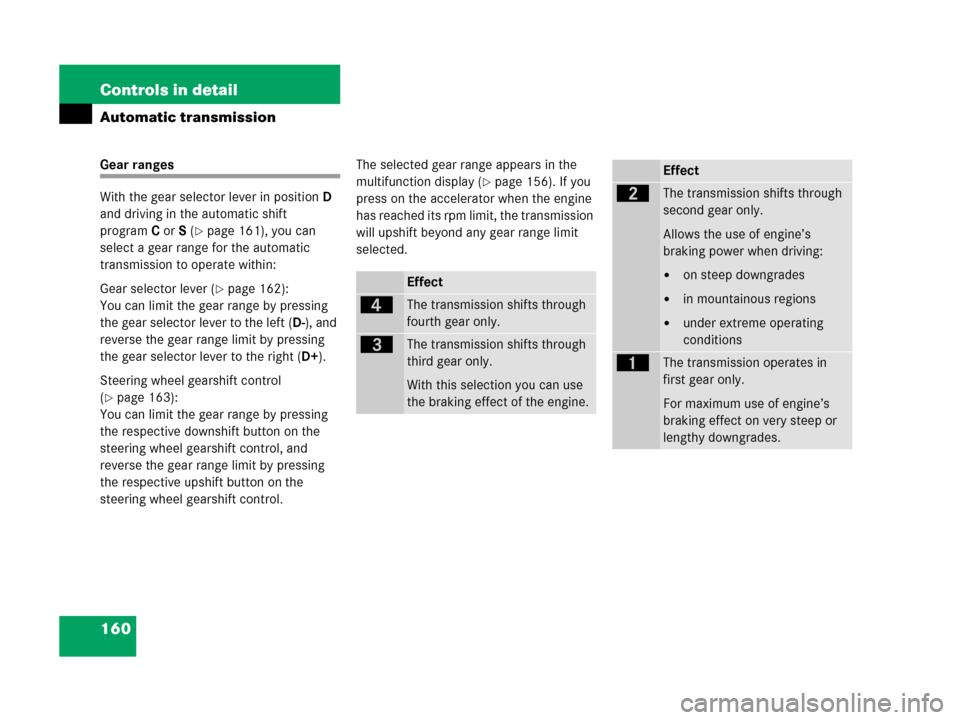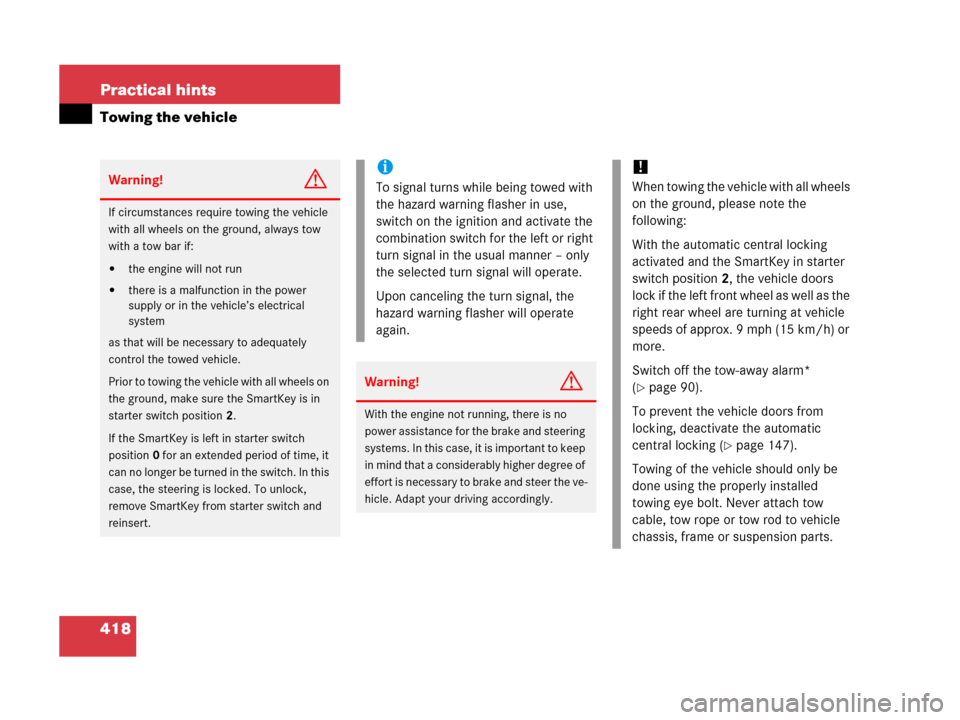Page 161 of 473

160 Controls in detail
Automatic transmission
Gear ranges
With the gear selector lever in positionD
and driving in the automatic shift
programC orS (
�page 161), you can
select a gear range for the automatic
transmission to operate within:
Gear selector lever (
�page 162):
You can limit the gear range by pressing
the gear selector lever to the left (D-), and
reverse the gear range limit by pressing
the gear selector lever to the right (D+).
Steering wheel gearshift control
(
�page 163):
You can limit the gear range by pressing
the respective downshift button on the
steering wheel gearshift control, and
reverse the gear range limit by pressing
the respective upshift button on the
steering wheel gearshift control.The selected gear range appears in the
multifunction display (
�page 156). If you
press on the accelerator when the engine
has reached its rpm limit, the transmission
will upshift beyond any gear range limit
selected.
Effect
éThe transmission shifts through
fourth gear only.
èThe transmission shifts through
third gear only.
With this selection you can use
the braking effect of the engine.
Effect
çThe transmission shifts through
second gear only.
Allows the use of engine’s
braking power when driving:
�on steep downgrades
�in mountainous regions
�under extreme operating
conditions
æThe transmission operates in
first gear only.
For maximum use of engine’s
braking effect on very steep or
lengthy downgrades.
Page 284 of 473

283 Operation
Driving instructions
�Driving instructions
Drive sensibly – save fuel
Fuel consumption, to a great extent,
depends on driving habits and operating
conditions.
To save fuel you should:
�Keep tires at the recommended tire
inflation pressures.
�Remove unnecessary loads.
�Remove roof rack when not in use.
�Allow engine to warm up under low
load use.
�Avoid frequent acceleration and decel-
eration.
�Have all maintenance work performed
at the intervals specified in the
Maintenance Booklet and as required
by the maintenance service display.
Contact an authorized Mercedes-Benz
Center.
Fuel consumption is also increased by
driving in cold weather, in stop-and-go
traffic, on short trips and in hilly area.
Drinking and drivingPedals
Power assistance
Warning!G
Drinking and driving and/or taking drugs
and driving are very dangerous combina-
tions. Even a small amount of alcohol or
drugs can affect your reflexes, perceptions
and judgment.
The possibility of a serious or even fatal
accident are greatly increased when you
drink or take drugs and drive.
Do not drink or take drugs and drive or allow
anyone to drive who has been drinking or
taking drugs.
Warning!G
Make sure that absolutely no objects are ob-
structing the pedals’ range of movement.
Keep the driver’s footwell clear of all obsta-
cles. If there are any floormats or carpets in
the footwell, make sure that the pedals still
have sufficient clearance.
Warning!G
With the engine not running, there is no
power assistance for the brake and steering
systems. In this case, it is important to keep
in mind that a considerably higher degree of
effort is necessary to brake and steer the
vehicle.
Page 332 of 473

331 Operation
Tires and wheels
Tire ply material
1Plies in sidewall
2Plies under tread
This marking tells you about the type of
cord and number of plies in the sidewall
and under the tread.Tire and loading terminology
Accessory weight
The combined weight (in excess of those
standard items which may be replaced) of
automatic transmission, power steering,
power brakes, power windows, power
seats, radio, and heater, to the extent that
these items are available as
factory-installed equipment (whether
installed or not).
Air pressure
The amount of air inside the tire pressing
outward on each square inch of the tire.
Air pressure is expressed in pounds per
square inch (psi), or kilopascal (kPa) or
bar.Aspect ratio
Dimensional relationship between tire
section height and section width
expressed in percentage.
Bar
Another metric unit for air pressure. There
are 14.5038 pounds per square inch (psi)
to 1 bar; there are 100 kilopascal (kPa)
to 1 bar.
Bead
The tire bead contains steel wires wrapped
by steel cords that hold the tire onto the
rim.
Cold tire inflation pressure
Tire inflation pressure when your vehicle
has been sitting for at least three hours or
driven no more than one mile (1.6 km).
i
For illustration purposes only. Actual
data on tires is specific to each vehicle
and may vary from data shown in above
illustration.
Page 379 of 473
378 Practical hints
What to do if …
Display symbolDisplay messagePossible cause/consequencePossible solution
Drive to workshopThe seat belt system is malfunctioning.�Visit an authorized Mercedes-Benz
Center as soon as possible.
_Steering oil
Visit workshopThe steering gear oil level is too low.
There is a danger of steering gear
damage.�Have the system checked by an
authorized Mercedes-Benz Center.
Warning!G
If the level of steering gear oil in reservoir is
too low, the steering power assistance could
fail. Much greater effort will then be needed
to turn the steering wheel.
Do not add steering oil without checking the
steering system.
Do not drive the vehicle. Have the system
checked at an authorized Mercedes-Benz
Center as soon as possible.
Page 419 of 473

418 Practical hints
Towing the vehicle
Warning!G
If circumstances require towing the vehicle
with all wheels on the ground, always tow
with a tow bar if:
�the engine will not run
�there is a malfunction in the power
supply or in the vehicle’s electrical
system
as that will be necessary to adequately
control the towed vehicle.
Prior to towing the vehicle with all wheels on
the ground, make sure the SmartKey is in
starter switch position2.
If the SmartKey is left in starter switch
position0 for an extended period of time, it
can no longer be turned in the switch. In this
case, the steering is locked. To unlock,
remove SmartKey from starter switch and
reinsert.
i
To signal turns while being towed with
the hazard warning flasher in use,
switch on the ignition and activate the
combination switch for the left or right
turn signal in the usual manner – only
the selected turn signal will operate.
Upon canceling the turn signal, the
hazard warning flasher will operate
again.
Warning!G
With the engine not running, there is no
power assistance for the brake and steering
systems. In this case, it is important to keep
in mind that a considerably higher degree of
effort is necessary to brake and steer the ve-
hicle. Adapt your driving accordingly.
!
When towing the vehicle with all wheels
on the ground, please note the
following:
With the automatic central locking
activated and the SmartKey in starter
switch position2, the vehicle doors
lock if the left front wheel as well as the
right rear wheel are turning at vehicle
speeds of approx. 9 mph (15 km/h) or
more.
Switch off the tow-away alarm*
(
�page 90).
To prevent the vehicle doors from
locking, deactivate the automatic
central locking (
�page 147).
Towing of the vehicle should only be
done using the properly installed
towing eye bolt. Never attach tow
cable, tow rope or tow rod to vehicle
chassis, frame or suspension parts.
Page 428 of 473
427 Technical data
Layout of poly-V-belt drive
�Layout of poly-V-belt drive
C55AMG
1Automatic belt tensioner
2Power steering pump
3Air conditioning compressor
4Crankshaft
5Coolant pump
6Generator (alternator)
7Idler pulley
Page 437 of 473

436 Technical data
Fuels, coolants, lubricants, etc.
Capacities
Vehicle components and their respectivelubricants must match. Therefore only use
products tested and approved by
Mercedes-Benz. Please refer to the Factory Approved
Service Products pamphlet, or inquire at
your Mercedes-Benz Center.
CapacityFuels, coolants, lubricants, etc.
Engine with oil filter9.0 US qt (8.5 l)Approved engine oils
Automatic transmission9.3 US qt (8.7 l)MB Automatic Transmission Fluid
Rear axle1.5 US qt (1.4 l)Hypoid gear oil SAE 85 W 90
Power steeringapprox. 1.1 US qt (1.0 l)MB Power Steering Fluid (Pentosin CHF 11S)
Front wheel hubsapprox. 2.1 oz (60 g) eachHigh temperature roller bearing grease
Brake system0.5 US qt (0.5 l)MB Brake Fluid (DOT 4+)
Cooling systemapprox. 12.8 US qt (12.0 l)MB 325.0 Anticorrosion/antifreeze agent
Fuel tank
including
a reserve of16.4 US gal (62.0 l)
2.6USgal (10.0l)Premium unleaded gasoline:
Minimum Posted Octane 91
(Avg. of 96 RON/86 MON)
Air conditioning systemR-134a refrigerant and special PAG lubricant oil
(never R-12)
Windshield washer3.2 US qt (3.0 l)MB Windshield Washer Concentrate1
1Use MB Windshield Washer Concentrate “MB SummerFit” and water for temperatures above freezing point or MB Windshield Washer Concentrate “MB SummerFit”
and commercially available premixed windshield washer solvent/antifreeze for temperatures below freezing point. Follow suggested mixing ratios (�page 442).
Windshield washer and headlamp
cleaning system*6.4 US qt (6.0 l)
Page 447 of 473

446 Technical terms
Maintenance System (U.S. vehicles)
Maintenance service indicator in the
multifunction display that informs the
driver when the next vehicle mainte-
nance service is due. The Maintenance
System in your vehicle tracks distance
driven and the time elapsed since your
last maintenance service, and calls for
the next maintenance service accord-
ingly.
Maximum load rating
(
�page 332)
Maximum loaded vehicle weight
(
�page 332)
Maximum tire inflation pressure
(
�page 333)
Memory function
Used to store three individual seat,
steering wheel and mirror positions.MON
(M
otor Octane Number)
The Motor Octane Number for gasoline
as determined by a standardized
method. It is an indication of a
gasoline’s ability to resist undesired
detonation (knocking). The average of
both the MON (Motor Octane Number)
and ->RON (Research Octane Number)
is posted at the pump, also known as
ANTI-KNOCK INDEX.
Multifunction display
Display field in the instrument cluster
used to present information provided
by the control system.
Multifunction steering wheel
Steering wheel with buttons for
operating the control system.
Normal occupant weight
(
�page 333)Overspeed range
Engine speeds within the red marking
of the tachometer dial. Avoid this
engine speed range, as it may result in
serious engine damage that is not
covered by the Mercedes-Benz Limited
Warranty.
Poly-V-belt drive
Drives engine-components (alternator,
AC compressor, etc.) from the engine.
Power train
Collective term designating all
components used to generate and
transmit motive power to the drive
axles, including
�engine
�clutch/torque converter
�transmission
�transfer case
�drive shaft
�differential
�axle shafts/axles